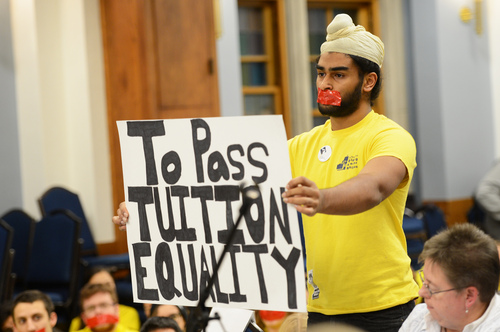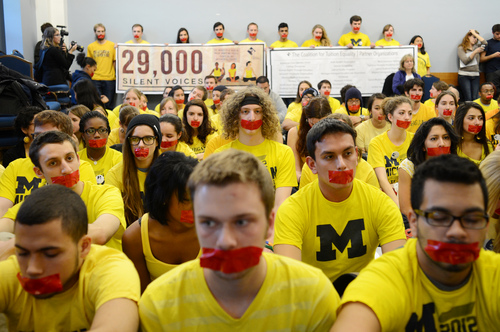Standing Up for Protests
Posted on December 15, 2019
Source: Melanie Maxwell I AnnArbor.com
“Petitions, occupations, strikes, vanguard parties, affinity groups, trade unions: all arose out of particular historical conditions. Protests such as the Stop the War and Occupy Wall Street lend an air of significance but accomplish nothing in themselves. In “Inventing the Future: Postcapitalism and a World Without Work” authors Nick Srnicek and Alex Williams offer such a criticism of the effectiveness of marches, protests, and marches, protests, and other acts of what they call “folk politics. I cannot comment on the effectiveness of these global and large-scale protests, but I have personally seen the power of protests have in changing policy on a local scale through a defined goal, compelling the administration to act in one way or another and organizing allies with a broad base.
Defining a goal
In 2012 a group of students at the University of Michigan started the Coalition for Tuition Equality (CTE), built with the goal of changing tuition policy to grant undocumented students in-state tuition. At the time, students could have lived in Michigan, went to school in Michigan, etc. but because they were undocumented, they did not qualify for in-state tuition. The Coalition consisted of 32 student organizations at University of Michigan, of which I was a part of one- the South Asian Activism Network. I represented our organization at CTE meetings.
CTE had a very specific and defined goal — to get in-state tuition for undocumented students. One of Nick Srnicek and Alex Williams’s criticism of the Occupy movement was that it “The Occupy movement infamously struggled to articulate meaningful goals, worried that anything too substantial would be divisive. And a broad range of student protests across the Western world has indeed taken up the mantra of ‘no demands under the misguided belief that demanding nothing is radical. But in CTE’s case, the students had a clear and narrow goal that they could always articulate and connect back to.
Compelling the administration to act
The University of Michigan has a deep history of protests and activism, especially in the 1960s. CTE brought that same fire and energy by organizing a series of protests, including a large student walkout at a Board of Regents meeting, protests outside the President’s office, sit-ins and more. These protests gained enough attention that the University formed a task force of students and regents to examine the current residency policies. One of the students on the task force, Sanjay Jolly said: “When Phil Hanlon [then-Provost] proposed this task force, it was 100 percent a measure for the University to drag their feet. They didn’t want to touch this. They wanted to show the world that they engage our students and we have a task force just for this issue.”

Source: Melanie Maxwell I AnnArbor.com
We didn’t give up. The protests, coordinated by the organizers, continued to put pressure on the administration and prove that students were unyielding. The protests gained more and more attention, and CTE got stronger. These movements did not allow the administration to drag their feet. Even some of the Regents applauded the protests. Mark Berstein, one of the Regents said “it [the protests] was a blueprint for effective advocacy. I was deeply moved by the stories that these students and their allies shared. They were very successful in attaching a human face to a not particularly interesting area of University governance. Storytelling is the most effective form of advocacy, and they mastered that.” Indeed, in my own friend group, after 5 or 6 heavily attended and public protests, it was hard to find anyone who was not aware of the cause.
Organize people from a broad base
In 2013, the regents passed new tuition equality guidelines by a 6-2 vote from the regents. Any student who attended middle school in Michigan for 2 years and a Michigan accredited high school for three years qualified to receive in-state tuition. Thus, groups who before were not able to get in-state tuition (such as undocumented students and veterans) were now able to claim in-state status. For an institution that is known to be slow-moving, this was a HUGE win. In less than 2 years, CTE was able to get the University to change its policy. And while there was a task force devoted to the cause, many (myself included) do not believe this would have happened as quickly as it did if it were not for the broad base upon which CTE was built.
Instead of starting a new student organization, CTE instead created a coalition and brought together existing University groups. When CTE started, it had about 12 members; less than two years later, it was a coalition of 32 student organizations. CTE was able to bring together a large and diverse body of students across interest groups. University of Michigan had over 600 student organizations and CTE was the largest effort to bring them together. If CTE hadn’t brought on my student organization, it would be unlikely that I would have gotten involved in the cause.
Protests in their own right don’t guarantee success. As said by Nathan Heller, “Is protest a productive use of our political attention? Or is it just a bit of social theatre we perform to make ourselves feel virtuous, useful, and in the right?”
In the case of tuition equality, the protests were way more than just social theatre.
SR
Bibliography
Heller, Nathan. 2019. “Is There Any Point to Protesting?” The New Yorker. 2019. https://www.newyorker.com/magazine/2017/08/21/is-there-any-point-to-protesting.
“Making a Movement: How a Small Group of Students United behind a Fringe Issue and Changed University Policy.” 2013. The Michigan Daily. 2013. https://www.michigandaily.com/article/coalition-tuition-equality.
Srnicek, Nick, and Alex Williams. 2016. Inventing the Future : Postcapitalism and a World without Work. London: Verso.
“Undocumented Students at ‘U’ Raise Concerns about Tuition Policy Appeals Process.” 2019. The Michigan Daily. 2019. https://www.michigandaily.com/section/administration/undocumented-students-%E2%80%98u%E2%80%99-raise-concerns-about-tuition-policy-appeals-process.
“University of Michigan Student Protesters Demand Tuition Equality for Illegal Immigrants.” 2012. AnnArbor.Com. 2012. http://www.annarbor.com/news/u-m-tuition-equality-in-play/.